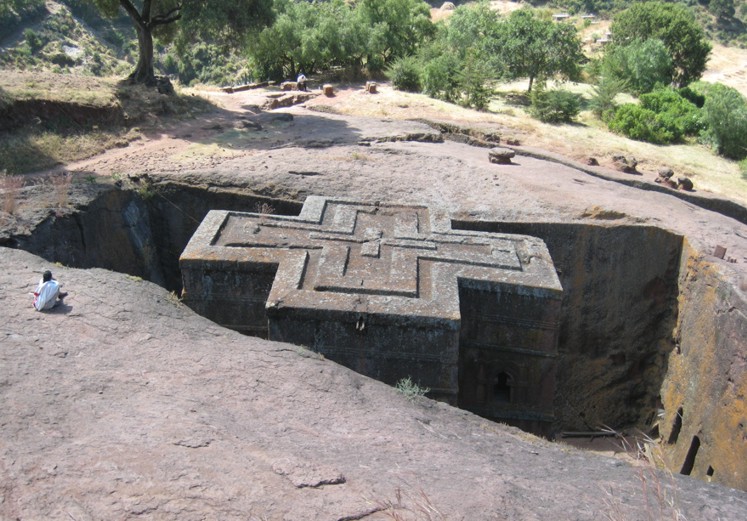Historic Mountains, Margin & Rift Valley fieldtrip
Saturday 14th January to Friday 20th January 2012
This fieldtrip is now full. We are investigating the possibility of extending the number of places. If you would like to be put on the waiting list please email addis2012@see.leeds.ac.uk
The Mountains, Margin and Rift Valley fieldtrip will follow a transect through the continental volcanic margin from the pre-rift flood basalts of the plateau, down the great escarpment, through the marginal graben structures and into the rift itself with its syn-rift volcanism and active magmatic segments. As well as areas of geological interest it will also visit famous historical sites including the ruins at Gondar and the churches at Lalibela.

Ethiopian Highlands
Cost: £775 per person including accommodation in Addis Ababa for the night of Friday 20th January.
Day 1: Addis – Gondar
Fly from Addis to Gondar with Ethiopian Airlines. Gondar is the old imperial capital of Ethiopia. Founded in the early seventeenth century, it is famous for its medieval castles and beautiful churches.
Day 2: Gondar – Debarek – Gondar
Debarek lays at the foot of the Simien Mountains. We will look at the famous Lima Limo section with its thick pre-rift flood basalts sequence and consider the mantle plume-related volcanic crisis that led to the plateau formation. We will also look at the regressive erosion of the plateau border. The Simien Mountains National Park is a World Heritage Site with a dramatic landscape of high mountains cut by deep valleys. It is home to walia ibex, gelada baboons and Ethiopian wolves.
Day 3: Gondar – Lake Tana – Lalibela
From Gondar we travel south to Lake Tana and then on to Lalibela. Lake Tana is the largest lake in Ethiopia and the source of the Blue Nile. Lalibela is famous for its rock-hewn churches. On the journey we will look at the flood basalts, the plateau preservation and dissection and the uplift and centrifuge drainage.

Church of St George at Lalibela
Day 4: Lalibela – Woldia
Travelling from Lalibela to Woldia provides the opportunity to study the development of the great escarpment and the Kobo basin, a typical marginal graben structure.
Day 5: Woldia – Hayk – Afar depression
We journey down into the Afar depression with time to study the morpho-tectonic evolution of the marginal graben, the structure, preservation and dissection of the flexured margin, the syn-rift volcanic and the Afar depression basins. Night in Mille or Loggia.
Day 6: Mille – Awash Station
Working south along the Afar depression we will look at the southern part of the active magmatic segment and the structure and petrology of the stratoid volcanic formations. The Awash River valley is famous for its hominid remains including 'Lucy', an Australopithecus afarensis, discovered in 1974, who lived about 3.2 million years ago.
Day 7: Awash Station – Addis
This morning provides a final chance to study the structure and volcanism of the Ethiopian Rift as well as the savannah fauna. Of historical interest is the famous Addis-Djibouti railway. We will arrive in Addis around lunchtime.
Fieldtrip expectation statement It is very important to read this before booking a place on the fieldtrip. It includes information, not only on what to expect, but on health, safety and insurance issues/requirements.

This is an outline of the planned route for the fieldtrip. Whilst we will endeavour to keep to this itinerary it is possible details may need to change. The exact itinerary will be finalized nearer the departure date.

